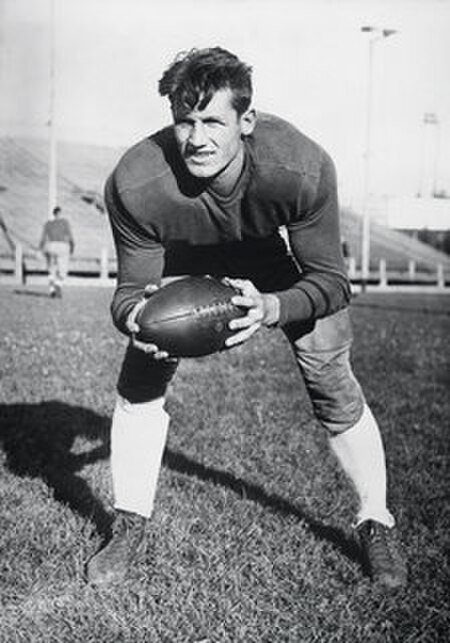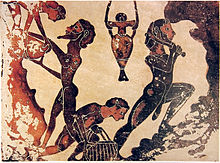Slavery in antiquity
|
Read other articles:

此條目可能包含不适用或被曲解的引用资料,部分内容的准确性无法被证實。 (2023年1月5日)请协助校核其中的错误以改善这篇条目。详情请参见条目的讨论页。 各国相关 主題列表 索引 国内生产总值 石油储量 国防预算 武装部队(军事) 官方语言 人口統計 人口密度 生育率 出生率 死亡率 自杀率 谋杀率 失业率 储蓄率 识字率 出口额 进口额 煤产量 发电量 监禁率 死刑 国债 外…

Park in California, United States of America Double-crested cormorant (Phalacrocorax auritus) at Shoreline Hayward Regional Shoreline is a regional park located on the shores of the San Francisco Bay in Hayward, California. It is part of the East Bay Regional Parks system. The 1,713-acre (693 ha) park extends to the shores of San Lorenzo.[1] Part of the park is former commercial salt flats purchased in 1996.[2] A former landfill, now capped with soil and plants, is located i…

Plaza Venezuela at Night Fisicromía - Homenaje a Don Andres Bello (1982), Carlos Cruz-Diez Plaza Venezuela (sunset). Marcos Kirschstein, 2018. Plaza Venezuela (Venezuela Square in Spanish) is a public square located in Los Caobos neighborhood, Caracas, Venezuela. It was inaugurated in 1940 and is situated in the geographic center of Caracas. Its place for many landmarks of Caracas, including a fountain with lights, the Christopher Columbus monument of Manuel de la Cova, the Fisicromía tribute …

Takashima 高島市Kota BenderaLambangLokasi Takashima di Prefektur ShigaNegara JepangWilayahKansaiPrefektur ShigaPemerintahan • Wali kotaMasaaki FukuiLuas • Total693 km2 (268 sq mi)Populasi (Oktober 1, 2015) • Total50.025 • Kepadatan72,19/km2 (187,0/sq mi)Zona waktuUTC+09:00Kode pos520-1592Nomor telepon0740-25-8000Alamat565 Shinasahichō Kitabata, Takashima-shi, Shiga-kenSitus webSitus web resmi Takashima (�…
2020年夏季奥林匹克运动会波兰代表團波兰国旗IOC編碼POLNOC波蘭奧林匹克委員會網站olimpijski.pl(英文)(波兰文)2020年夏季奥林匹克运动会(東京)2021年7月23日至8月8日(受2019冠状病毒病疫情影响推迟,但仍保留原定名称)運動員206參賽項目24个大项旗手开幕式:帕维尔·科热尼奥夫斯基(游泳)和马娅·沃什乔夫斯卡(自行车)[1]闭幕式:卡罗利娜·纳亚(皮划艇)[2…

习近平 习近平自2012年出任中共中央总书记成为最高领导人期间,因其废除国家主席任期限制、开启总书记第三任期、集权统治、公共政策与理念、知识水平和自述经历等争议,被中国大陸及其他地区的民众以其争议事件、个人特征及姓名谐音创作负面称呼,用以恶搞、讽刺或批评习近平。对习近平的相关负面称呼在互联网上已经形成了一种活跃、独特的辱包亚文化。 权力類 �…

Alex BalfanzLahir5 Mei 1999 (umur 25)Orlando, FloridaKebangsaanAmerikaNama lainbadcc, badccvoidPekerjaanPengembang video gameDikenal atasProgrammer dan co-pembuat dari permainan Roblox Jailbreak Alex Balfanz (lahir 5 Mei 1999) adalah pengembang video game Amerika yang paling dikenal sebagai programmer dan co-creator dari Jailbreak game Roblox. Masa muda Lahir pada tahun 1999, Balfanz mulai membuat kode game menggunakan Roblox Studio pada usia 9 tahun.[1] Ayah Balfanz bekerja se…

American football player (1913–2002) American football player Ward CuffNo. 14Position:Halfback, PlacekickerPersonal informationBorn:(1913-08-12)August 12, 1913Redwood Falls, Minnesota, U.S.Died:December 24, 2002(2002-12-24) (aged 89)Vallejo, California, U.S.Height:6 ft 1 in (1.85 m)Weight:192 lb (87 kg)Career informationHigh school:Redwood FallsCollege:MarquetteNFL draft:1937 / Round: 4 / Pick: 34Career history New York Giants (1937–1945) Chi…

Pemandangan Jalan Casablanca dan Jalan Dr. Satrio dari jembatan penyebrangan Kota Kasablanka. Jalan Casablanca atau Kasablanka adalah jalan utama di Jakarta yang menghubungkan Kampung Melayu dan Karet Belakang (masuk kelurahan Karet Kuningan). Nama jalan ini adalah singkatan dari Kampung Melayu sampai belakang Karet dan nama sebuah kota di negara Maroko. Jalan sepanjang 1,6 kilometer membentang dari perempatan jalan Dr. Saharjo—Letjen Soepomo (Menteng Dalam, Tebet, Jakarta Selatan) sampai Tero…

See also: 2022 IIHF World U18 Championships International ice hockey competition 2022 IIHF U18 World Championship Division ITournament detailsHost countries Slovakia ItalyVenue(s)2 (in 2 host cities)Dates11–17 April (Group A)25 April – 1 May (Group B)Teams12← 2021 (cancelled)← 20192023 → The 2022 IIHF U18 World Championship Division I was two international under-18 ice hockey tournaments organised by the International Ice Hockey Federation. The Division…

Хозарський каганат ← 650 – 969 → Розвиток Хозарського каганату Столиця Семендер, Ітиль Мова(и) хозарська Релігія язичництво, юдаїзм, іслам, християнство Населення хозари, слов'яни, алани, печеніги Вікісховище має мультимедійні даніза темою: Хозарський каганат Понтійсь…

Prosopocera valida Klasifikasi ilmiah Kerajaan: Animalia Filum: Arthropoda Kelas: Insecta Ordo: Coleoptera Famili: Cerambycidae Genus: Prosopocera Spesies: Prosopocera valida Prosopocera valida adalah spesies kumbang tanduk panjang yang berasal dari famili Cerambycidae. Spesies ini juga merupakan bagian dari genus Prosopocera, ordo Coleoptera, kelas Insecta, filum Arthropoda, dan kingdom Animalia. Larva kumbang ini biasanya mengebor ke dalam kayu dan dapat menyebabkan kerusakan pada batang kayu …

Dalam nama Korean ini, nama keluarganya adalah Moon. Moon Ga-youngMoon pada 2018Lahir10 Juli 1996 (umur 27)Karlsruhe, Baden-Württemberg, JermanKebangsaanKorea SelatanPekerjaanAktrisTahun aktif2006–sekarangAgenKeyEast[1]Nama KoreaHangul문가영 Hanja文佳煐 Alih AksaraMun Ka-youngMcCune–ReischauerMun Kayŏng Moon Ga-young (Hangul: 문가영; lahir pada 10 Juli 1996) adalah seorang aktris Korea Selatan kelahiran Jerman. Dia dikenal baik karena perannya pada seri …

Yulius Bustami Informasi pribadiLahir21 Juli 1965 (umur 58)Surabaya, Jawa TimurPartai politikPKSAlma materAkademi Angkatan Laut (1988)Karier militerPihak IndonesiaDinas/cabang TNI Angkatan LautMasa dinas1988—2010Pangkat KolonelNRP9186/PSatuanKomando Pasukan KatakSunting kotak info • L • B Kolonel Laut (T) (Purn.) Yulius Bustami (lahir 21 Juli 1965) adalah seorang Purnawirawan TNI-AL yang terakhir menjabat sebagai Komandan Satuan Pasukan Katak Koarmatim.[1]&…

Governing body for basketball in Canada Canada BasketballFormation1923; 101 years ago (1923)TypeNational Governing Body (NGB)LocationToronto, OntarioRegion served CanadaOfficial language EnglishFrenchCEOMichael BartlettKey peopleRowan Barrett (GM)Steve Nash (senior advisor)AffiliationsFIBAFIBA AmericasWebsitebasketball.ca Canada Basketball is the governing body for basketball in Canada. Headquartered in Toronto, Ontario, the federation is a full member of FIBA and governs Canad…

Disambiguazione – Se stai cercando la parte dello schieramento militare usata tatticamente come riserva, vedi Riserva militare (tattica). Agosto 1914. L'imbarco della Australian Naval and Military Expeditionary Force diretta in Nuova Guinea. Era un contingente di volontari — in parte tratto da riservisti della marina di vari stati, in parte dalla milizia — inviato a combattere nelle vicine colonie tedesche. La riserva militare è un'organizzazione composta di cittadini di uno Stato che pre…

Soft, fine feather, sometimes under larger feathers Down feathers lack the interlocking barbules of pennaceous feathers, making them very soft and fluffy. The down of birds is a layer of fine feathers found under the tougher exterior feathers. Very young birds are clad only in down. Powder down is a specialized type of down found only in a few groups of birds. Down is a fine thermal insulator and padding, used in goods such as jackets, bedding (duvets and featherbeds), pillows and sleeping bags.…

هذه المقالة بحاجة لصندوق معلومات. فضلًا ساعد في تحسين هذه المقالة بإضافة صندوق معلومات مخصص إليها. أعضاء في منظمة شباب هتلر يقومون بتشغيل جهاز رصد الأجسام بالصدى. شباب هتلر أثناء عملهم كطاقم على جهاز كشاف مضاد للطائرات في برلين (1943). مساعد قوة جوية (المعروف أيضًا باسم فلاشيلف�…

هذه المقالة تحتاج للمزيد من الوصلات للمقالات الأخرى للمساعدة في ترابط مقالات الموسوعة. فضلًا ساعد في تحسين هذه المقالة بإضافة وصلات إلى المقالات المتعلقة بها الموجودة في النص الحالي. (ديسمبر 2018) مقاطعة ميتكالف الإحداثيات 36°59′N 85°38′W / 36.99°N 85.63°W / 36.99; -85.63 …

منتخب النمسا تحت 21 سنة لكرة القدم بلد الرياضة النمسا الفئة كرة قدم تحت 21 سنة للرجال [لغات أخرى] رمز الفيفا AUT المدرب فيرنر غريغوريتش القائد كيفين دانسو مشاركات تعديل مصدري - تعديل منتخب النمسا تحت 21 سنة لكرة القدم هو الممثل الرسمي للنمسا في بطولات…




